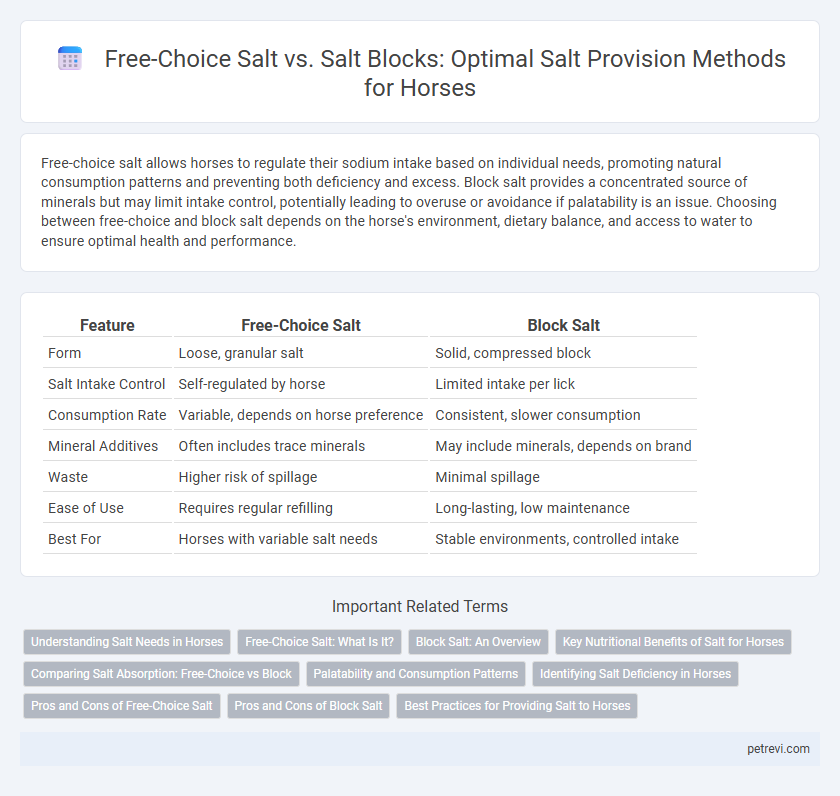Free-choice salt allows horses to regulate their sodium intake based on individual needs, promoting natural consumption patterns and preventing both deficiency and excess. Block salt provides a concentrated source of minerals but may limit intake control, potentially leading to overuse or avoidance if palatability is an issue. Choosing between free-choice and block salt depends on the horse's environment, dietary balance, and access to water to ensure optimal health and performance.
Table of Comparison
| Feature | Free-Choice Salt | Block Salt |
|---|---|---|
| Form | Loose, granular salt | Solid, compressed block |
| Salt Intake Control | Self-regulated by horse | Limited intake per lick |
| Consumption Rate | Variable, depends on horse preference | Consistent, slower consumption |
| Mineral Additives | Often includes trace minerals | May include minerals, depends on brand |
| Waste | Higher risk of spillage | Minimal spillage |
| Ease of Use | Requires regular refilling | Long-lasting, low maintenance |
| Best For | Horses with variable salt needs | Stable environments, controlled intake |
Understanding Salt Needs in Horses
Horses require sodium and chloride for muscle function, nerve transmission, and hydration, making salt provision essential for their health. Free-choice salt allows horses to self-regulate intake based on individual needs, which can vary due to factors like exercise, diet, and climate. In contrast, block salt provides a fixed amount but may limit intake flexibility, potentially leading to either overconsumption or deficiency if horses cannot adjust their salt intake appropriately.
Free-Choice Salt: What Is It?
Free-choice salt for horses refers to loose granular salt provided separately, allowing horses to self-regulate their sodium intake based on individual needs. This method supports natural feeding behavior and can help prevent mineral imbalances by enabling horses to consume salt at varying rates according to activity level, sweat loss, and diet. Research indicates free-choice salt improves hydration and electrolyte balance more effectively than fixed block salt, which may limit access or intake.
Block Salt: An Overview
Block salt provides a consistent source of essential minerals like sodium and chloride, promoting electrolyte balance and preventing dehydration in horses. Its solid form reduces waste and allows horses to lick as needed, supporting natural intake regulation and minimizing overconsumption. Durable and weather-resistant, block salt remains available in various environmental conditions, making it an effective and economical choice for long-term salt provision.
Key Nutritional Benefits of Salt for Horses
Free-choice salt allows horses to self-regulate their sodium intake, supporting optimal hydration and electrolyte balance essential for muscle function and nerve transmission. Block salt provides a controlled source of sodium but may limit consumption flexibility, potentially affecting metabolic processes and overall performance. Ensuring adequate salt intake promotes proper digestion, enhances nutrient absorption, and maintains cardiovascular health in horses.
Comparing Salt Absorption: Free-Choice vs Block
Free-choice salt allows horses to regulate their intake based on individual needs, promoting optimal sodium absorption and preventing deficiencies. Block salt, while convenient, may limit access and reduce overall consumption, potentially leading to suboptimal sodium levels. Studies indicate that free-choice provision supports better electrolyte balance and hydration compared to block salt.
Palatability and Consumption Patterns
Free-choice salt allows horses to regulate their intake according to individual needs, promoting natural consumption patterns and reducing the risk of overconsumption. Block salt tends to have lower palatability compared to loose salt, which can lead to inconsistent salt consumption and potential deficiencies. Ensuring adequate salt intake is crucial for maintaining electrolyte balance and overall equine health.
Identifying Salt Deficiency in Horses
Horses exhibiting signs of salt deficiency often show increased water intake, excessive sweating, and decreased appetite, indicating an urgent need for adequate sodium replacement. Free-choice salt allows horses to self-regulate their intake based on individual requirements, promoting healthier electrolyte balance, whereas block salt may limit access and result in inconsistent consumption. Monitoring daily salt intake along with observing behavioral cues is essential for preventing hyponatremia and maintaining optimal hydration and muscle function in horses.
Pros and Cons of Free-Choice Salt
Free-choice salt allows horses to self-regulate their sodium intake, reducing the risk of overconsumption and ensuring individual dietary needs are met. This method promotes natural behavior but may lead to inconsistent intake if the salt is not palatable or exposed properly. Horses on free-choice salt require monitoring to ensure they consume enough salt, especially in hot climates or during heavy exercise.
Pros and Cons of Block Salt
Block salt provides a controlled, long-lasting mineral source for horses, reducing wastage compared to free-choice salt. However, its solid form can limit intake regulation, potentially leading to under- or overconsumption of sodium. Maintenance issues such as weather-induced erosion or contamination may affect block salt's overall efficacy on horse health and hydration.
Best Practices for Providing Salt to Horses
Free-choice salt provision allows horses to regulate their own sodium intake, supporting optimal hydration and electrolyte balance, especially during periods of heavy sweating or intense exercise. Block salt, typically harder and more compact, can reduce wastage and provide a slow release of salt, though some horses may prefer the ease of access offered by loose salt. Ensuring clean, fresh water is always available alongside either form of salt is essential for maintaining proper mineral absorption and overall equine health.
Free-Choice Salt vs Block Salt for Horse Salt Provision Infographic

 petrevi.com
petrevi.com